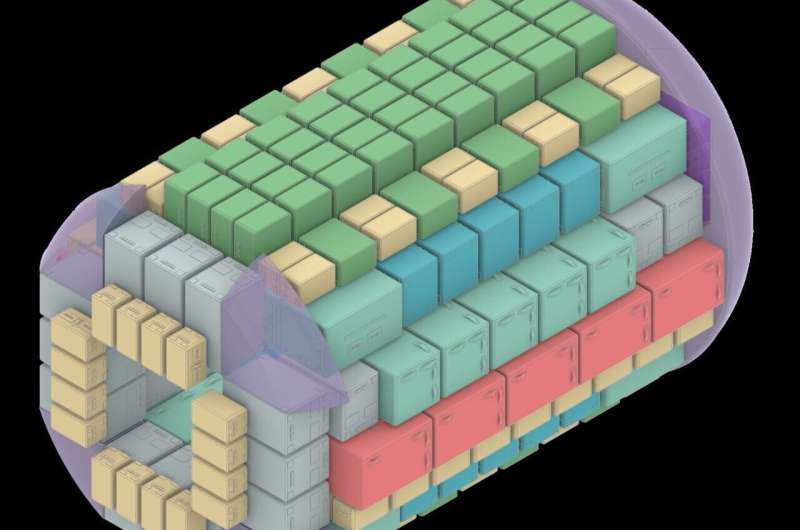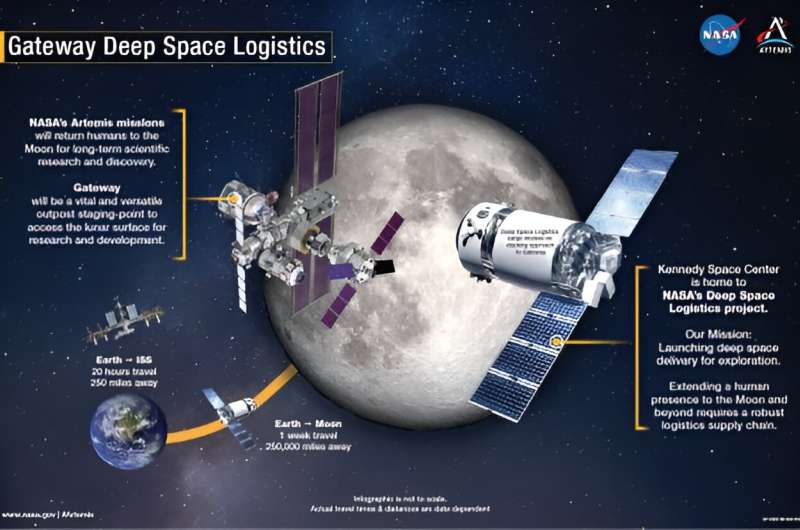This article has been reviewed according to Science X's editorial process and policies. Editors have highlighted the following attributes while ensuring the content's credibility:
fact-checked
trusted source
proofread
What's the best way to pack for space?

Packing to go to space is a lot like getting ready for a plane ride with only a carry-on bag. You have to maximize the use of the space in your bag at the same time you want to make sure you have what you need. That's the challenge astronauts face in the upcoming Artemis moon missions. So, NASA held a competition to figure out the best and most innovative ways to store cargo for the missions.
The Lunar Gateway Cargo Packing and Storing challenge asked members of the public to come up with good ways to pack materials in the limited space on the lunar Gateway that will be orbiting the moon. The idea inspired some 90 participants from 35 countries to step up and show off their packing skills. It also helped that there were cash prizes for the winners. Everybody submitted written solutions and 3D computer models to show what could be done for astronauts who would need easy, quick access to their cargo.
The design parameters had to take into account storing the cargo delivered to the gateway by the logistics module. The most efficient space design would allow astronauts to access the cargo easily in the module, which will also be their food and supply storage room, plus a place to store trash. So, given everything that needs to be placed there efficiently, the idea was to maximize volume and minimize mass.
The best design came from Austria, made by designer Kriso Leinfellner. It's called QASIS, short for Quick Access Storage in Space. It's a fairly straightforward method of stacking and packing that maximizes the amount of space the cargo takes up. It also proposes lightweight storage structures and does not rely on motors or batteries to power cranes or other equipment to move the boxes.
Leinfellner won $3,000.00 for this design.
Four other prizes of amounts ranging from $2,000.00 to $250.00 were awarded to winners from Turkey, Brazil, Nigeria, and Germany. They took into account launch and orbital conditions, and several specified manual and/or automated systems to move cargo around for access.

Packing space for Artemis and the Gateway
The Artemis program will have multiple missions, and the logistics will vary with each crew or cargo trip. So, the "packing space" challenge used the following scenario. A crew of four launches in the Orion capsule on top of an SLS rocket on a three-week mission to the Gateway. Two crew members will then travel on to the moon to spend a week of exploration and science experiments. Before the crew arrives at Gateway, it will have already been visited by an uncrewed Logistics module packed with supplies. It will be there waiting for the astronauts to arrive about a week later.
Just to make things more complicated, there won't be a lot of space available at the Gateway. NASA's plans show that the station will be about the size of a one-bedroom apartment, so a fraction of the size of the International Space Station. Once the astronauts get there, they'll move in, using an internal system to help them stow the supplies. The contest asked entrants to design that stowage system.
Artemis Mission overview
The Artemis mission is an ambitious long-range plan for lunar exploration and eventual habitation. It focuses primarily on scientific exploration of the lunar surface. Lessons learned on the moon will translate to longer-term missions to Mars. The Gateway part of the mission is crucial. It provides an orbiting space station on the moon, which will function as a transfer point and supply depot.
There are Deep Space Logistics project offices at the Johnson Space Center in Houston. However, the Kennedy Space Center is responsible for leading the commercial supply chain. That team solicits and procures bids for cargo transport, equipment acquisition, and consumable supplies for the mission—both in the gateway and on the lunar surface.
Why such a complex chain? It's a complex mission, involving the construction of the Gateway, which requires transport of materials to the "construction site" in lunar orbit. It's going to be there for several years, so long-term viability is important. It serves as the link to the lunar surface and so it will become the staging area for materials needed on the moon for bases and installations.
Everything for Artemis and its Gateway has to withstand the rigors of launch, orbital insertion at the moon, and use/reuse by the astronauts who will be passing through. Five Artemis missions will happen. Others are still in the proposal stages. Artemis 1 flew in 2022 as an uncrewed test flight. It "practiced" putting Orion into lunar orbit and then brought the capsule back to Earth.
Artemis 2 could fly in late 2025, although that will likely slip. It will be the first crewed test flight and will do orbital testing around Earth and the moon. Artemis 3 will be the first crewed lunar landing, bringing a diverse set of astronauts to the newly built lunar Gateway and then to the moon. After that, Artemis 4 and 5 will fly (dates still to be determined) and will take astronauts to the gateway and lunar surface for further explorations.
Provided by Universe Today





















